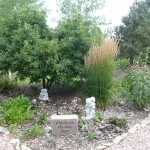History
1994
The Idea
The idea for the Courage Garden was born following the First Courage Walk hosted by Victim Outreach Information (VOI) in April, 1994. VOI is a police based crime victim assistance program. VOI Advocates conceptualized The Courage Walk as a way to recognize and honor the victims of crime during National Crime Victim’s Rights Week. This was a pledge walk with donations to VOI to support our mission. The first was held at Crown Hill Park – a lovely walk attended by about 40 people. We received permission to plant an aspen tree, but were not allowed to install a plaque to commemorate the event. Following the walk, VOI contacted District Attorney, Dave Thomas with the idea of establishing a memorial garden for crime victims, a place we could hold an Annual Courage Walk and plant a tree or bush in honor of crime victims. With his support, and that of Jefferson County Commissioners, an area on the southwest side of the Jefferson County Courts and Administration was allocated for the garden, with the agreement it could be used as a memorial garden for crime victims as well as for county employees.
1995
The Beginning
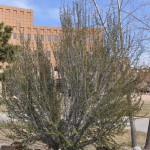 VOI solicited the help of a Landscape Architect to develop a master plan early 1995. Molly St. Denis, a student at the CU Denver Masters of Landscape Architecture, volunteered her services and designed the garden. It would serve as a place for memorial plantings, complete with a gazebo surrounded by established trees, a place of solace and respite from dealing with crime and subsequent legal proceedings, and a place of memory for victims and employees of Jefferson County. A plant list was developed with the goal that the garden would also serve as an educational garden for plants that would thrive in this climate zone. Guidelines for memorial plantings were established with the agreement brass plaques to mark the site would be standard. Responsibility for providing guidance and permission falls to VOI.
VOI solicited the help of a Landscape Architect to develop a master plan early 1995. Molly St. Denis, a student at the CU Denver Masters of Landscape Architecture, volunteered her services and designed the garden. It would serve as a place for memorial plantings, complete with a gazebo surrounded by established trees, a place of solace and respite from dealing with crime and subsequent legal proceedings, and a place of memory for victims and employees of Jefferson County. A plant list was developed with the goal that the garden would also serve as an educational garden for plants that would thrive in this climate zone. Guidelines for memorial plantings were established with the agreement brass plaques to mark the site would be standard. Responsibility for providing guidance and permission falls to VOI.
VOI’s Second Annual Courage Walk was held on April 29th, 1995. The event was overshadowed by the tragic news that the day before the walk, April 28, 1995, Jefferson County Sheriff Deputy Sgt. Timothy Mossbrucker was killed in the line of duty when he responded to a domestic violence related homicide. Following a moment of silence and a statement from the District Attorney read by his wife, Shirley Thomas, a curl-leaf mountain mahogany was planted, a plant used in Native American healing ceremonies.
Later that year, the master plan was approved by Jefferson County Commissioners and the Courage Garden was formally established. A Ceremony was held on December 7, 1995 to dedicate the garden to Victims of Crime – Past, Present and Future, to Jefferson County Employees and to Sgt. Timothy Mossbrucker.
1996
The Gazebo and Pond
Work on the garden began – Jefferson County Facilities created trails with red breeze, installed teakwood benches and built the foundation for a gazebo. One employee also built the pond.
VOI researched gazebo choices and decided on a gazebo kit by Dalton Pavilions. With donations from all of Jefferson County’s law enforcement agencies, including the District Attorney’s Office, and a donation to the effort by Dalton Pavilions, Inc., the gazebo kit was purchased. A group of Evergreen Lutheran Church Members, Hank Salvey, Henry Kerschbaum, Glen Lein, Irving Antweiller and Bill Exline, built the Gazebo. It too was dedicated to Sgt. Mossbrucker. The Gazebo was built and donors were formally recognized on June 1, 1996. The eagle that tops the gazebo was donated by Lee Suttie, formerly with Jefferson County Facilities.
When VOI Board President Alan Fear retired in 1996, he left us the gift of the flagstone that borders the pond (created by a Jefferson County Facilities employee).
The flagstone carving on the pond headstone reads:
Courage Garden
This garden is dedicated to innocent victims of crime
past, present and future;
To the wonder of the human spirit;
To the courage of those who reclaim their lives
and move beyond victimization;
And to hope for a safer future.
VOI – 1996
1997
The Children’s Garden
In 1997 the Children’s Garden was developed and a dwarf plum tree planted in memory of a little girl who was a victim of homicide. A Native American Shaman attended the Courage Walk and offered a blessing to the garden.
With the understanding that there are many ways to honor spirit, and the recognition that an event such as the Courage Walk demands the opportunity for prayer, VOI encourages diversity in the selection of leaders of various faiths to attend the walk. We have been blessed by representatives from many faiths, such as a group of Buddhists Monks who chanted prayer, Korean drummers, Native American healers and Police Chaplains. We will continue to invite those of various faiths to lead us in prayer.
Under guidance from Joan Truby, Denver Rose Society and with the help of volunteers Becky Cook, Vista Exline and Sharon Mason, roses were purchased and planted around the Gazebo.
1998
Courage Walk at Bear Creek
In 1998 the Courage Walk was held at Bear Creek and a tree was planted behind the Police Department.
1999
Courage Walk at Field Park, Wheat Ridge
In 1999, the Courage Walk was held at Field Park in Wheat Ridge to recognize the efforts of the Durbin Family whose son drowned in Clear Creek. They were instrumental in reconfiguring the creek to remove the dangerous spillway to make it safer for future kayakers. This walk was held two days following the tragic shootings at Columbine High School.
2000
Remembrance and Renewal Garden
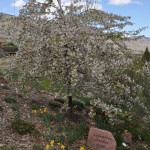 In 2000, the Remembrance and Renewal Garden was created, with a drift of columbine to symbolize the April 1999 tragic homicides of students and a teacher at Columbine High School. A weeping crab apple, a donation from Timberline Gardens, was planted as a memoriam.
In 2000, the Remembrance and Renewal Garden was created, with a drift of columbine to symbolize the April 1999 tragic homicides of students and a teacher at Columbine High School. A weeping crab apple, a donation from Timberline Gardens, was planted as a memoriam.
2004
West garden entry flagstone
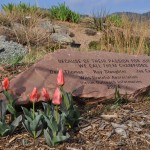 In September of 2004, a ceremony was hosted by VOI to recognize and honor three individuals who have championed the rights and needs of victims of crime: Dave Thomas, District Attorney, Raymond Slaughter, Director of Criminal Justice and Joseph Cassa, Interim Chief for the Wheat Ridge Police Department. An engraved flagstone was installed at the entry to the garden. Also in September 2004, bids to build an arbor entry to the garden were solicited.
In September of 2004, a ceremony was hosted by VOI to recognize and honor three individuals who have championed the rights and needs of victims of crime: Dave Thomas, District Attorney, Raymond Slaughter, Director of Criminal Justice and Joseph Cassa, Interim Chief for the Wheat Ridge Police Department. An engraved flagstone was installed at the entry to the garden. Also in September 2004, bids to build an arbor entry to the garden were solicited.
2005
Courage Garden Arbor
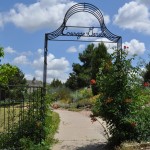 In April 2005 the Courage Garden Arbor was installed at the west entrance. The arbor was created by Dennis West, 23rd Avenue Sculpture Studio, Denver.
In April 2005 the Courage Garden Arbor was installed at the west entrance. The arbor was created by Dennis West, 23rd Avenue Sculpture Studio, Denver.
2008
Birdhouse
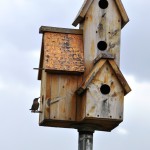 In 2008, a tall bird house was installed on the west side of the gazebo garden. Additionally, to encourage participation, VOI made the decision that the Courage Walk officially be a walk sponsored by all victim service providers in the 1st Judicial District, rather than just VOI. Proceeds from pledges now go toward the maintenance of the Courage Garden and for victim services needs. The walk now includes the addition of the Clothesline Project with displays of art drawn on t-shirts by victims with messages of healing and hope.
In 2008, a tall bird house was installed on the west side of the gazebo garden. Additionally, to encourage participation, VOI made the decision that the Courage Walk officially be a walk sponsored by all victim service providers in the 1st Judicial District, rather than just VOI. Proceeds from pledges now go toward the maintenance of the Courage Garden and for victim services needs. The walk now includes the addition of the Clothesline Project with displays of art drawn on t-shirts by victims with messages of healing and hope.
2015
Bench to honor law enforcement officer
David Michael Baldwin
1963-2014
Killed in the line of duty January 26, 2014, in north Jefferson County, Colorado.
Sergeant David Baldwin was struck on his motorcycle by a wrong-way driver on Highway 93. Baldwin, a 27-year veteran was conducting traffic patrol at the time. The driver was traveling southbound on the wrong side of the road to pass another vehicle when the collision occurred. He later plead guilty to vehicular homicide and was sentenced to six years in community corrections.
Donations & Volunteer History
Survivor of crime, Tina Holcome, was the initial gardener. She and her children watered and weeded the first plantings up until 1998. She also had the idea to release doves at the Courage Walks.
_______________________________________________________________________________________________________________________________________________________
Arapahoe Acres Nursery
Arapahoe Acres Nursery donated the curl-leaf mountain mahogany, the first Courage Garden planting, the plum tree for the Children’s Garden, a Juniper and Pinon Pine that borders the west side of the xeriscape garden on the north side of the garden, and 3 Chinese Catalpa Trees (planted April, 2002)
_______________________________________________________________________________________________________________________________________________________
White Birds Unlimited
Tom Loux, White Birds Unlimited, donates the release of doves each year at the Courage Walk.
_______________________________________________________________________________________________________________________________________________________
Master Gardeners
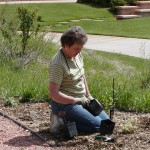 In 1999, Judy DiCroce, VOI Volunteer and a Master Gardener, offered to help with the garden. She received permission to solicit help from other master gardeners and since that time the Courage Garden has been a demonstration garden of the Jefferson County Extension Master Gardeners. In May, 2001, Judy had the soil tested and received recommendations for fertilization.
In 1999, Judy DiCroce, VOI Volunteer and a Master Gardener, offered to help with the garden. She received permission to solicit help from other master gardeners and since that time the Courage Garden has been a demonstration garden of the Jefferson County Extension Master Gardeners. In May, 2001, Judy had the soil tested and received recommendations for fertilization.
Children’s Garden
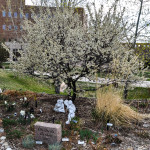 This garden was established in 1997 with the planting of a dwarf ornamental plum tree. Since then it has thrived (even though it had Leafcurl Plum aphids one year) and every April, for about a week, depending on the weather, the tree is covered with tiny white and fragrant flowers whose scent will draw you in the moment you reach the entrance to the gardens. The tree grows in a round habit and becomes very full with leaves and some small ornamental fruits that provide sustenance for the birds. The fall color is a golden yellow. We discovered the aphid overwinters in plants in the composite (Asteraceae) family. The aphid was no longer a problem once we moved the composite family plants to another area. This was accomplished without pesticides and is called Integrated Pest Management, an ecosystem based strategy. Now we don’t have to worry about wasps following the aphid “honeydew” while we are gardening in that area. Although this garden is irrigated we still choose low water plants for this garden which has a sunny side and a shady side. We have had success with Penstemon mexicali varieties, dianthus, soapwort, iris, agastache, sage, Joe Pye weed, speedwell, Purple Mountain and Avalanche sun daisy, mountain bluet, purple coneflower and candytuft. Some plants that didn’t work for us were avens, gaura, liatris, red birds in a tree, silver blade evening primrose, silver sage and forget me not. We are not there all the time to check on the plants and there could be any number of reasons why a plant doesn’t overwinter or perishes during the season (including critters) even though it is in our zone and is planted according to its moisture and sun requirements. The best we can do is give it another try elsewhere in the gardens and hope for the best.
This garden was established in 1997 with the planting of a dwarf ornamental plum tree. Since then it has thrived (even though it had Leafcurl Plum aphids one year) and every April, for about a week, depending on the weather, the tree is covered with tiny white and fragrant flowers whose scent will draw you in the moment you reach the entrance to the gardens. The tree grows in a round habit and becomes very full with leaves and some small ornamental fruits that provide sustenance for the birds. The fall color is a golden yellow. We discovered the aphid overwinters in plants in the composite (Asteraceae) family. The aphid was no longer a problem once we moved the composite family plants to another area. This was accomplished without pesticides and is called Integrated Pest Management, an ecosystem based strategy. Now we don’t have to worry about wasps following the aphid “honeydew” while we are gardening in that area. Although this garden is irrigated we still choose low water plants for this garden which has a sunny side and a shady side. We have had success with Penstemon mexicali varieties, dianthus, soapwort, iris, agastache, sage, Joe Pye weed, speedwell, Purple Mountain and Avalanche sun daisy, mountain bluet, purple coneflower and candytuft. Some plants that didn’t work for us were avens, gaura, liatris, red birds in a tree, silver blade evening primrose, silver sage and forget me not. We are not there all the time to check on the plants and there could be any number of reasons why a plant doesn’t overwinter or perishes during the season (including critters) even though it is in our zone and is planted according to its moisture and sun requirements. The best we can do is give it another try elsewhere in the gardens and hope for the best.
Daylily/Pond Garden
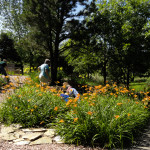
 There is a mass stand of orange daylilies on both sides of a single file path that leads to a small pond. The daylilies were planted in 1996 by Eagle Scout candidate Sean Ravston and have been going strong ever since. They are very drought tolerant and just easy going and reliably bloom en masse in mid-July. I don’t know the exact cultivar. The pond has a year round population of resident goldfish that live among the Marsh marigold, Helvola water lily, and floaters that keep the pond clean. Thank you to Jeffco Master Gardener Melba Johnston for being the pond expert for 10+years. 2016 we hope to have some blooms from a zephyr lily…..
There is a mass stand of orange daylilies on both sides of a single file path that leads to a small pond. The daylilies were planted in 1996 by Eagle Scout candidate Sean Ravston and have been going strong ever since. They are very drought tolerant and just easy going and reliably bloom en masse in mid-July. I don’t know the exact cultivar. The pond has a year round population of resident goldfish that live among the Marsh marigold, Helvola water lily, and floaters that keep the pond clean. Thank you to Jeffco Master Gardener Melba Johnston for being the pond expert for 10+years. 2016 we hope to have some blooms from a zephyr lily…..
Maurice Bauer Garden
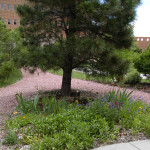 The focal point of the Maurice Bauer Garden is a Ponderosa pine. The area closest to the sidewalk is irrigated (part-shade) and the back side is not irrigated at all (dry shade). The dry shade area has a few slow growing patches of Oregon grape and Cascade manzanita (newly planted Fall 2015). The yellow spring flowers of the Oregon grape will support the local bumblebee population with much needed pollen after a long winter. It will be interesting to see how much rabbit pressure the Cascade manzanita can tolerate. We have a high population of rabbits that like to sharpen their teeth over the winter on the woody plants . The irrigated side has a variety of plants including Iris lactea, bearded iris, spiderwort, tickseed, blanket flower, grape hyacinth, evening primrose, ozark coneflower, red hot poker, Rozanne geranium, sedum groundcover, daffodils, purple coneflower, autumn crocus, fall blooming asters, scarlet pincushion and two Worcester Gold blue mist spirea. Unfortunately, for the garden, it is being loved to death by the voles and the rabbits for which we have no controls. We may have to cut back or remove some of the ground cover plants to eliminate a cover for the voles and see if that helps.
The focal point of the Maurice Bauer Garden is a Ponderosa pine. The area closest to the sidewalk is irrigated (part-shade) and the back side is not irrigated at all (dry shade). The dry shade area has a few slow growing patches of Oregon grape and Cascade manzanita (newly planted Fall 2015). The yellow spring flowers of the Oregon grape will support the local bumblebee population with much needed pollen after a long winter. It will be interesting to see how much rabbit pressure the Cascade manzanita can tolerate. We have a high population of rabbits that like to sharpen their teeth over the winter on the woody plants . The irrigated side has a variety of plants including Iris lactea, bearded iris, spiderwort, tickseed, blanket flower, grape hyacinth, evening primrose, ozark coneflower, red hot poker, Rozanne geranium, sedum groundcover, daffodils, purple coneflower, autumn crocus, fall blooming asters, scarlet pincushion and two Worcester Gold blue mist spirea. Unfortunately, for the garden, it is being loved to death by the voles and the rabbits for which we have no controls. We may have to cut back or remove some of the ground cover plants to eliminate a cover for the voles and see if that helps.
Gazebo Garden
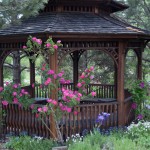 The gazebo was built in 1996. The first rose bushes were planted in 1997 and we are still enjoying one of the original rose bushes, John Cabot. This garden has a minimal irrigation system (just a few spray heads around the perimeter). The east side of the gazebo is dry-somewhat moist shade while the west side is dry-somewhat moist part-sun/full sun. The shade loving plants in this garden are heucheras, heucherella, creeping jenny, dead nettle, japanese painted fern, and bugleweed. The part-sun/full sun plants in this garden are clematis, roses, siberian bugloss, candytuft and daffodils. This garden has been relatively free from vole and rabbit damage (except for the occasional pruning of clematis by the rabbits).
The gazebo was built in 1996. The first rose bushes were planted in 1997 and we are still enjoying one of the original rose bushes, John Cabot. This garden has a minimal irrigation system (just a few spray heads around the perimeter). The east side of the gazebo is dry-somewhat moist shade while the west side is dry-somewhat moist part-sun/full sun. The shade loving plants in this garden are heucheras, heucherella, creeping jenny, dead nettle, japanese painted fern, and bugleweed. The part-sun/full sun plants in this garden are clematis, roses, siberian bugloss, candytuft and daffodils. This garden has been relatively free from vole and rabbit damage (except for the occasional pruning of clematis by the rabbits).
Herb Garden
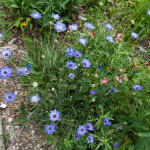 This garden is on the west side of the gazebo, is lightly irrigated and is in full sun. The main plants in this garden are roses, lavender and purple coneflower. Also growing in this garden are butterfly blue pincushion, cupid’s dart, candy tuft, species tulips, fall blooming asters, Rozanne geranium, tickseed, tuberous cranesbill and a volunteer sugarbowl clematis. The voles moved into this garden in 2015 so we may have to manage the Rozanne geranium to minimize their hiding places.
This garden is on the west side of the gazebo, is lightly irrigated and is in full sun. The main plants in this garden are roses, lavender and purple coneflower. Also growing in this garden are butterfly blue pincushion, cupid’s dart, candy tuft, species tulips, fall blooming asters, Rozanne geranium, tickseed, tuberous cranesbill and a volunteer sugarbowl clematis. The voles moved into this garden in 2015 so we may have to manage the Rozanne geranium to minimize their hiding places.
Columbine Garden
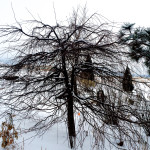
 Seeing the crabapple tree in winter, stripped of all its blossoms, all its fruit, all its leaves, it seems like it is truly weeping with all its being for all the Columbine victims and all the crime victims remembered in these memorial gardens. All winter it is subjected to screaming winds and freezing temperatures. And then next thing you know it is spring and, if we are lucky, the tree will burst forth with blossoms of life for the bees, blossoms of hope for the people affected by tragedy. To me, this tree represents the “wonder of the human spirit and the courage to reclaim their lives and move beyond victimization” and it also represents the very real struggles of gardening. Every year new twisted branches emerge and life continues. This garden probably receives the most moisture. Some of the plants growing in this garden are bee balm, columbines, day lilies, penstemons, may night sage, neon stonecrop, pasque flower (may have been munched), purple coneflower, purple mountain sun daisy, russian sage, fall blooming asters, shasta daisy, daffodils, pig squeak, peony, milkweed, self heal, tickseed, trollius, species and hybrid tulips. It is a favorite with the birds, the bees, the rabbits and the voles.
Seeing the crabapple tree in winter, stripped of all its blossoms, all its fruit, all its leaves, it seems like it is truly weeping with all its being for all the Columbine victims and all the crime victims remembered in these memorial gardens. All winter it is subjected to screaming winds and freezing temperatures. And then next thing you know it is spring and, if we are lucky, the tree will burst forth with blossoms of life for the bees, blossoms of hope for the people affected by tragedy. To me, this tree represents the “wonder of the human spirit and the courage to reclaim their lives and move beyond victimization” and it also represents the very real struggles of gardening. Every year new twisted branches emerge and life continues. This garden probably receives the most moisture. Some of the plants growing in this garden are bee balm, columbines, day lilies, penstemons, may night sage, neon stonecrop, pasque flower (may have been munched), purple coneflower, purple mountain sun daisy, russian sage, fall blooming asters, shasta daisy, daffodils, pig squeak, peony, milkweed, self heal, tickseed, trollius, species and hybrid tulips. It is a favorite with the birds, the bees, the rabbits and the voles.
Fall Color Garden
 The fall color garden, on the east side of the Columbine garden, was added in 2011 by Mary Dobrovolny and Loretta Simms to attract pollinators such as hummingbirds, butterflies and bumblebees and demonstrate late season blooms. This garden features agastaches, neon stonecrop, coneflowers, goldenrod and spring blooming anemone blanda.
The fall color garden, on the east side of the Columbine garden, was added in 2011 by Mary Dobrovolny and Loretta Simms to attract pollinators such as hummingbirds, butterflies and bumblebees and demonstrate late season blooms. This garden features agastaches, neon stonecrop, coneflowers, goldenrod and spring blooming anemone blanda.
Xeriscape Garden
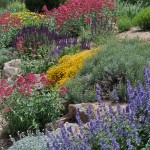 Judy and her husband Tony spearheaded the installation of a xeriscape garden in 2004. Sadly, Judy Di Croce suddenly passed away in November 2008. Master Gardener Loretta Simms, assumed the leadership of this devoted group. We miss Judy’s guidance,kindness, enthusiasm and ever present smile. Many Jefferson County Master Gardeners have cared for these gardens over the years and continue the path that was forged by Judy, Tony (her husband) and many other tenacious Master Gardeners. This garden does not receive supplemental irrigation and the soil was not amended. Plants growing in this garden include sedums, basket of gold, bearded iris, blanket flower, blaze little bluestem, blue fescue, candytuft, daffodils, dwarf iris, giant sacaton grass, hens & chicks, hopflower oregano, ice plant, iris reticulata, catmints, juniper thyme, jupiter’s beard, lace cactus, lavender, lavender cotton, lemon balm, missouri evening primrose, moonshine yarrow, mt. atlas daisy, partridge feather, purple coneflower, purple winter savory, red yucca (rabbit damage), penstemons, russian sage, sea foam artemisia, silver edged horehound, snakeweed, agastaches, species tulips, hybrid tulips, wild four o’clock, winecups (rabbit food), rock rose, false indigo bush, worcester gold blue mist spirea, blue flax, Coral Canyon twinspur, gayfeather, bluebell of scotland, may night sage and Maximilians sunflower. In 2015 we lost Bluestem joint fir, Hardy dwarf broom and a lavender cotton plant to root damage from the voles. The plants had a good 10 year run.
Judy and her husband Tony spearheaded the installation of a xeriscape garden in 2004. Sadly, Judy Di Croce suddenly passed away in November 2008. Master Gardener Loretta Simms, assumed the leadership of this devoted group. We miss Judy’s guidance,kindness, enthusiasm and ever present smile. Many Jefferson County Master Gardeners have cared for these gardens over the years and continue the path that was forged by Judy, Tony (her husband) and many other tenacious Master Gardeners. This garden does not receive supplemental irrigation and the soil was not amended. Plants growing in this garden include sedums, basket of gold, bearded iris, blanket flower, blaze little bluestem, blue fescue, candytuft, daffodils, dwarf iris, giant sacaton grass, hens & chicks, hopflower oregano, ice plant, iris reticulata, catmints, juniper thyme, jupiter’s beard, lace cactus, lavender, lavender cotton, lemon balm, missouri evening primrose, moonshine yarrow, mt. atlas daisy, partridge feather, purple coneflower, purple winter savory, red yucca (rabbit damage), penstemons, russian sage, sea foam artemisia, silver edged horehound, snakeweed, agastaches, species tulips, hybrid tulips, wild four o’clock, winecups (rabbit food), rock rose, false indigo bush, worcester gold blue mist spirea, blue flax, Coral Canyon twinspur, gayfeather, bluebell of scotland, may night sage and Maximilians sunflower. In 2015 we lost Bluestem joint fir, Hardy dwarf broom and a lavender cotton plant to root damage from the voles. The plants had a good 10 year run.
Courage Garden Metal Arch Entrance
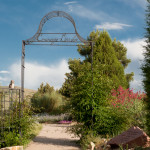 This entrance arch is on the west end of the memorial gardens. There is a small garden there. The soil was not amended and the plants do not receive supplemental irrigation. In this garden we have trumpet vine, cactus, blanket flower, blue flax, iris danfordiae, species tulips, purple prairie clover, cushion spurge, sulfur flower, pussytoes. Several xeric plants were added in fall 2015 so we are anxiously awaiting spring to see how they fared.
This entrance arch is on the west end of the memorial gardens. There is a small garden there. The soil was not amended and the plants do not receive supplemental irrigation. In this garden we have trumpet vine, cactus, blanket flower, blue flax, iris danfordiae, species tulips, purple prairie clover, cushion spurge, sulfur flower, pussytoes. Several xeric plants were added in fall 2015 so we are anxiously awaiting spring to see how they fared.
Kiosk
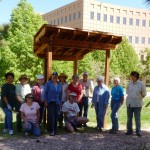 The dream that the Courage Garden became an educational garden as well as a memorial garden officially came true with the installation of a kiosk to house an education book. At the encouragement of Loretta Simms, Jefferson County Extension Master Gardener, a kiosk was built at the garden in 2012. Signage was installed in 2009, photos taken and information printed. Loretta created a website, www.couragegardenplants.com that offers information about successful plantings at the Courage Garden.
The dream that the Courage Garden became an educational garden as well as a memorial garden officially came true with the installation of a kiosk to house an education book. At the encouragement of Loretta Simms, Jefferson County Extension Master Gardener, a kiosk was built at the garden in 2012. Signage was installed in 2009, photos taken and information printed. Loretta created a website, www.couragegardenplants.com that offers information about successful plantings at the Courage Garden.
Bee House
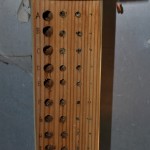 This is a bee house for solitary bees that has been at the Courage Garden since summer 2013. The bee/wasp block provide rearing chambers for the next generation. There are several native bees and wasps in Colorado that are solitary, such as leafcutter and mason bees. They are considered cavity nesters and have evolved to use hollow plant stems and holes in wood to lay their eggs. This bee house was part of a University of Colorado at Boulder Citizen Scientist project called The Bees Needs. http://beesneeds.colorado.edu/ The purpose of the project is to study the various native bees and wasps along Colorado’s Front Range. The wood block was constructed with a variety of diameter holes and each hole had a letter and number assigned to it, for example A3 (Row A, Column 3). Throughout the summer we probed each hole to determine if it was being used. The holes are a little less than 4″ deep. As time went on, some of the holes became shallower, meaning something was filling up the hole. We reported the depth of each hole and what material was being used to plug the hole. For example, is it resin, is it mud, is it sawdust, is it mud and rocks or is it leaves? All this information along with the diameter of the hole can tell the researchers which type of solitary bee or wasp is laying eggs in the hole without even seeing the bee. But sometimes you get lucky and you do see the bee. These bees are not aggressive and do not mind being watched.
This is a bee house for solitary bees that has been at the Courage Garden since summer 2013. The bee/wasp block provide rearing chambers for the next generation. There are several native bees and wasps in Colorado that are solitary, such as leafcutter and mason bees. They are considered cavity nesters and have evolved to use hollow plant stems and holes in wood to lay their eggs. This bee house was part of a University of Colorado at Boulder Citizen Scientist project called The Bees Needs. http://beesneeds.colorado.edu/ The purpose of the project is to study the various native bees and wasps along Colorado’s Front Range. The wood block was constructed with a variety of diameter holes and each hole had a letter and number assigned to it, for example A3 (Row A, Column 3). Throughout the summer we probed each hole to determine if it was being used. The holes are a little less than 4″ deep. As time went on, some of the holes became shallower, meaning something was filling up the hole. We reported the depth of each hole and what material was being used to plug the hole. For example, is it resin, is it mud, is it sawdust, is it mud and rocks or is it leaves? All this information along with the diameter of the hole can tell the researchers which type of solitary bee or wasp is laying eggs in the hole without even seeing the bee. But sometimes you get lucky and you do see the bee. These bees are not aggressive and do not mind being watched.
 If you can enlarge this photo and look into hole D3 you will see the rear end of a solitary bee. I thought it looked like the rear end of a leaf cutter bee. Then, as I looked around I did see some leaves that looked as though something had cut a piece out of the leaf.
If you can enlarge this photo and look into hole D3 you will see the rear end of a solitary bee. I thought it looked like the rear end of a leaf cutter bee. Then, as I looked around I did see some leaves that looked as though something had cut a piece out of the leaf.
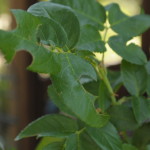 Leaf cutter bees line the nesting chamber with a little piece of leaf and then fly off to gather some pollen. She lays the pollen on top of the leaf and then lays the egg next to the pollen so her young will have some food when it becomes a larvae.
Leaf cutter bees line the nesting chamber with a little piece of leaf and then fly off to gather some pollen. She lays the pollen on top of the leaf and then lays the egg next to the pollen so her young will have some food when it becomes a larvae.
 She will lay her eggs in this hole, one at a time and put up a partition between each egg. This is a cross section of a bee block from the Butterfly Pavillion in Westminster that demonstrates what the nesting chamber looks like inside the block. Sometime in spring we will notice a little hole in the plug which means the bees have emerged to carry on the next generation.
She will lay her eggs in this hole, one at a time and put up a partition between each egg. This is a cross section of a bee block from the Butterfly Pavillion in Westminster that demonstrates what the nesting chamber looks like inside the block. Sometime in spring we will notice a little hole in the plug which means the bees have emerged to carry on the next generation.
There are 946 native bees documented in Colorado that provide essential pollination . 210 of these species have been documented in Jefferson County. We attempt to provide plants that provide nectar and pollen for these important pollinators at the Courage Garden which brings me to our next project.
Colorado Native Plants seeding project
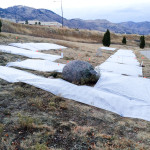 In November 2015 we seeded a short grass prairie field (buffalo grass/blue grama) with Colorado native plant seeds, most locally collected and a few purchased. We hope to demonstrate native plants from both the Eastern and Western Slope of Colorado. Prior to seeding the following plants were installed in the field: Artemisia frigida, Ipomoea leptophylla and Thelesperma megapotamicum. This is an open field in a windy area so we applied 15% row cover to the seeded plots to protect the seeds over the winter but only block a small amount of light and moisture. The field is not irrigated and doesn’t appear to be excessively weedy. The following native plants were already growing in this field: Fleabane, Curly cup gumweed, snakeweed, gayfeather, rabbitbrush and yucca glauca. The row cover was secured with landscape pins and, as of 2/14/16, has remained intact. I will update this post later in the year.
In November 2015 we seeded a short grass prairie field (buffalo grass/blue grama) with Colorado native plant seeds, most locally collected and a few purchased. We hope to demonstrate native plants from both the Eastern and Western Slope of Colorado. Prior to seeding the following plants were installed in the field: Artemisia frigida, Ipomoea leptophylla and Thelesperma megapotamicum. This is an open field in a windy area so we applied 15% row cover to the seeded plots to protect the seeds over the winter but only block a small amount of light and moisture. The field is not irrigated and doesn’t appear to be excessively weedy. The following native plants were already growing in this field: Fleabane, Curly cup gumweed, snakeweed, gayfeather, rabbitbrush and yucca glauca. The row cover was secured with landscape pins and, as of 2/14/16, has remained intact. I will update this post later in the year.
_______________________________________________________________________________________________________________________________________________________
Eagle Scouts
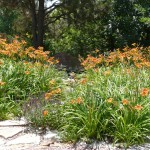 In 1996, Sean Ravston, a candidate for Eagle Scouts, asked if he could do a project for the garden. Following a design by Molly St. Denis, Sean and his fellow scouts created a flagstone path to the pond and planted daylilies on either side.
In 1996, Sean Ravston, a candidate for Eagle Scouts, asked if he could do a project for the garden. Following a design by Molly St. Denis, Sean and his fellow scouts created a flagstone path to the pond and planted daylilies on either side.
In October 2001, Tony Sonderby, another Eagle Scout, completed a path to the Catalpas. A bench was installed at the end of the path to recognize the donations of the Master Gardeners.
In 2012, Joel Meyer, gathered a team of boy scouts and refinished the Gazebo for his Eagle Scout Project.
 In 2015, scouts from Troop 231 in Arvada repaired the graffiti and refinished the gazebo benches. Thank you to Joel Meyer, Connor White, Chris Eldrige, Samuel Garner, Freddie Budgell, Abe Hooten, Jesse Budgell and Brayden Arellano-Carpenter.
In 2015, scouts from Troop 231 in Arvada repaired the graffiti and refinished the gazebo benches. Thank you to Joel Meyer, Connor White, Chris Eldrige, Samuel Garner, Freddie Budgell, Abe Hooten, Jesse Budgell and Brayden Arellano-Carpenter.

